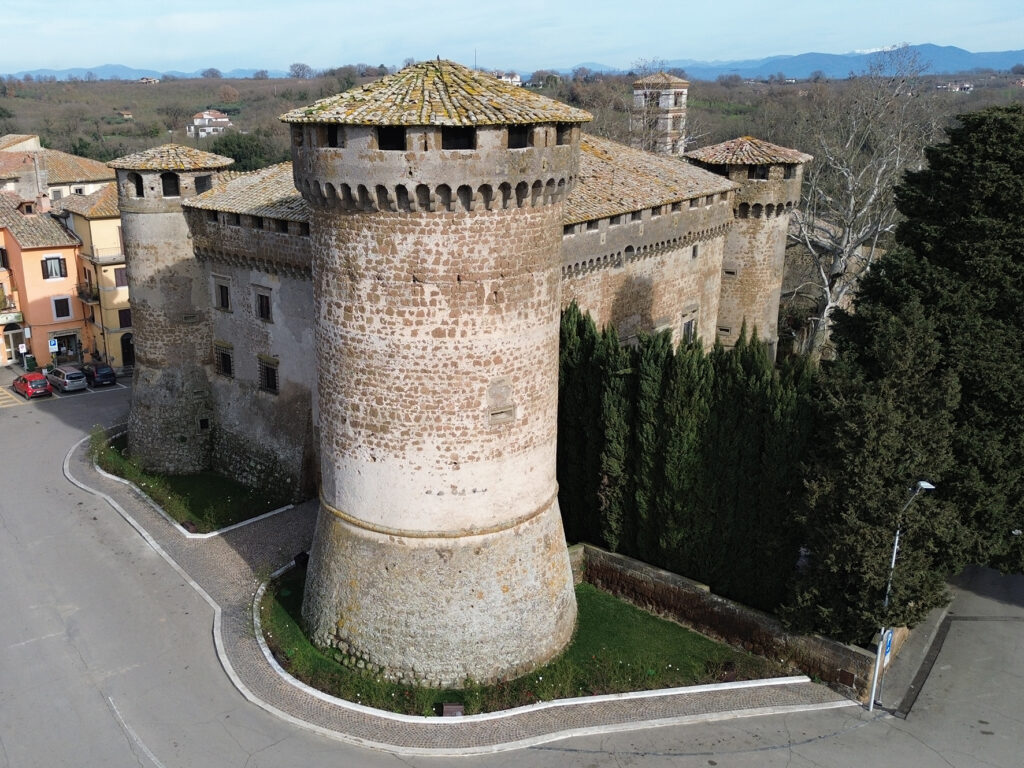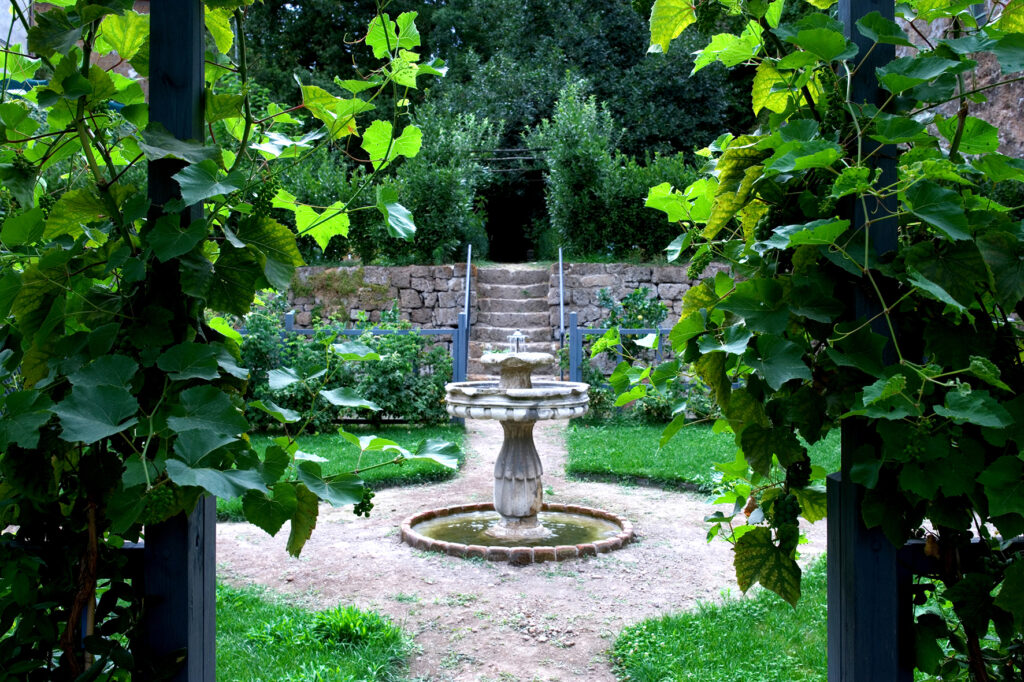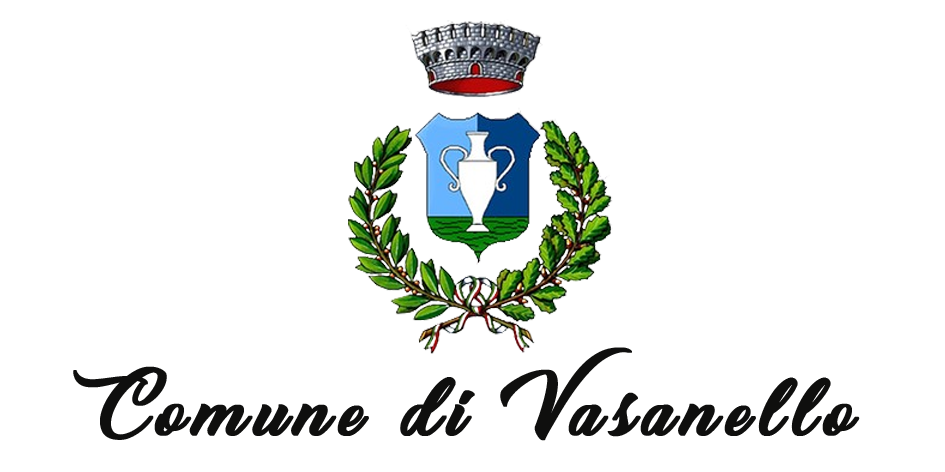Il Castello
The Castel


Dopo la seconda battaglia del Lago Vadimóne, nel 283 a.C. (vedi n° 21, “Lago Vadimóne”), che porterà nel giro di pochi anni all’assimilazione della civiltà etrusca ed anche del fiero popolo stanziato in questo territorio, i Falisci, Roma stabilì qui un avamposto militare che ha tutte le carte in regola per essere individuato con il Castello Amerino della Carta Peutingeriana (Fonte: “Castello Amerino”, Giorgio Fabiani, S.ED Editore, Viterbo, 2010).
Chiaro allora che il castello che vediamo oggi è sorto sul primevo fortilizio romano che, sfruttando la base del triangolo formato dalle due profonde forre ai lati del pianoro confluenti verso nord, di fatto rendeva necessaria la bastionatura difensiva del castrum soltanto sul lato meridionale. E infatti, ancora fino al 1885 il torrione sud-ovest del castello era ancora unito ad una torre quadra poi trasformatasi, intorno al X secolo, nel campanile della chiesa di Santa Maria Assunta (vedi n. 2,
“Il Muraglione che non c’è più”). Il basamento di una identica torre si trova non distante all’abside della chiesa, in fondo alla discesa del cosiddetto Stretto, che, unito allo Steccato – dove si trova il parcheggio multipiano -, altri non era che il vallo artificiale romano fungente da fossato difensivo. Le prime notizie documentate risalgono tuttavia al 1278, allorché Orso Orsini strappa il feudo dell’allora Bassanello alla Chiesa e, per cercare di mantenerne il possesso, fa potenziare il fortilizio romano. Non serve però a molto, poiché appena quattro anni dopo, nel 1282, lo zio, papa Martino IV, lo costringe a restituire il maltolto. Il paese conosce il suo periodo di maggiore fama all’epoca del pontificato di Callisto III, a partire dal 1455, allorché giunge a Roma dalla nativa Spagna una sua alquanto acuta nipote: Adriana Del Milà.
Dopo una ridda di piuttosto affettuose amicizie, la fanciulla si marita con Ludovico Orsini Migliorati, signore di Bassanello, al quale dà un figlio, Orsino, che oltre alla già traumatica esperienza di perdere un occhio giovanissimo – monoculus Ursinus – si ritrova come madre una delle più sciagurate arriviste che la storia ricordi. Al punto che, quando nel 1492 il di lei cugino Rodrigo Borja, alias Alessandro VI, assurge al soglio pontificio, non esita a servirgli i favori della nuora Giulia Farnese su un piatto d’argento. È in occasione delle nozze tra Orsino e Giulia che viene commissionato il primo ciclo di affreschi del Castello: affreschi accostati, in particolare per quanto riguarda il bestiario decorativo di fregi e cassettoni soffittali, a Pintoricchio e bottega.
Nel 1505, in concomitanza delle nozze tra Laura Orsini – figlia di Giulia – e Nicola Della Rovere, al precedente ciclo di affreschi vengono aggiunti dei riferimenti che celebrano anche la famiglia dello sposo: tra questi lo stemma in pietra posto sulla sommità del bel portone in peperino all’ingresso. Alla morte di Nicola, nel 1534, il feudo è ereditato dal figlio Giulio e, in seguito, dalla sorella Elena, sposa di Stefano Colonna. Nel 1728 Giulio Cesare Colonna si unisce in matrimonio a Cornelia Barberini e assume anche il cognome della moglie.
Nel 1810 il blasone si estende ulteriormente in Barberini Colonna di Sciarra. L’ultimo di questo ramo della famiglia ad ereditare il castello è Maffeo, al quale, a causa degli innumerevoli debiti contratti in imprese speculative disastrose, viene però espropriato al principio del Novecento dalla Banca d’Italia. Di lì a poco l’istituto bancario propone l’acquisto di tutti i beni al consorzio della locale Università Agraria, che limita tuttavia il suo interesse ai soli latifondi, ritenendo il castello – pure facente parte dell’intero “pacchetto” – un onere incompatibile con le sue funzioni statutarie. Il castello viene così acquistato, nel 1907, dal viceprefetto dei palazzi apostolici monsignor Luigi Misciattelli, i cui eredi ne sono ancora oggi proprietari.
After the Second Battle of Lake Vadimone in 283 BC (see No. 21, “Lake Vadimone”), which, within a few years, led to the assimilation of the Etruscan civilization as well as the proud people inhabiting this territory, the Falisci, Rome established a military outpost here. This outpost has all the characteristics to be identified with the Castello Amerino mentioned in the Tabula Peutingeriana (Source: Castello Amerino, Giorgio Fabiani, S.ED Editore, Viterbo, 2010).
It is therefore clear that the castle we see today was built on the original Roman fortification. Exploiting the triangular base formed by the two deep ravines flanking the plateau and converging northward, this fortification required defensive bastioning only on its southern side. Indeed, up until 1885, the castle’s southwest tower was still connected to a square tower, which around the 10th century was transformed into the bell tower of the Church of Santa Maria Assunta (see No. 2, “The Wall That Is No More”). The foundation of a similar tower can still be found near the church’s apse, at the bottom of the so-called Stretto descent. This, along with Lo Steccato—now the location of a multi-story parking lot—was originally an artificial Roman ditch serving as a defensive moat.
The first documented records of the castle date back to 1278, when Orso Orsini seized the fief of what was then called Bassanello from the Church. In an attempt to retain control, he reinforced the Roman fortification. However, this effort proved futile, as just four years later, in 1282, his uncle, Pope Martin IV, forced him to return the unlawfully taken land.
The town reached its peak of fame during the papacy of Callixtus III, beginning in 1455, when his astute niece, Adriana Del Milà, arrived in Rome from her native Spain. After a series of rather affectionate friendships, she married Ludovico Orsini Migliorati, lord of Bassanello, with whom she had a son, Orsino. Besides the traumatic experience of losing an eye at a young age—earning him the nickname monoculus Ursinus—Orsino also had the misfortune of having one of history’s most notorious social climbers as a mother. So much so that when, in 1492, her cousin Rodrigo Borja (better known as Pope Alexander VI) ascended to the papal throne, she did not hesitate to offer him the favors of her daughter-in-law, Giulia Farnese, on a silver platter.
It was on the occasion of Orsino and Giulia’s wedding that the first cycle of frescoes in the castle was commissioned. These frescoes, particularly the decorative bestiary adorning the friezes and coffered ceilings, have been stylistically linked to Pinturicchio and his workshop. In 1505, during the wedding of Laura Orsini—Giulia’s daughter—and Nicola Della Rovere, new frescoes were added, incorporating references celebrating the groom’s family. Among these additions is the stone coat of arms placed atop the beautiful peperino stone doorway at the entrance.
Upon Nicola’s death in 1534, the fief passed to his son Giulio and later to his sister Elena, who married Stefano Colonna. In 1728, Giulio Cesare Colonna married Cornelia Barberini, adopting his wife’s surname as well. By 1810, the family’s name had expanded further to Barberini Colonna di Sciarra.
The last member of this branch to inherit the castle was Maffeo, who, due to the enormous debts he accumulated through disastrous speculative ventures, was forced to forfeit it to the Bank of Italy in the early 20th century. Shortly afterward, the bank offered the estate for sale to the local Università Agraria consortium, which, however, limited its interest to the vast farmlands, deeming the castle—also included in the sale—a burden incompatible with its institutional functions. As a result, in 1907, the castle was purchased by Monsignor Luigi Misciattelli, vice-prefect of the Apostolic Palaces, whose heirs still own it today.


